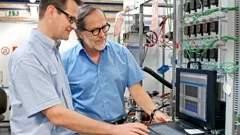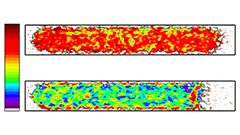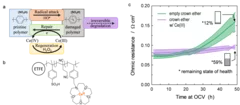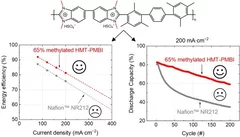Recherche
Der Weg der Schweiz zum Netto-Null-Ziel
Die ETH-Institutionen bündeln ihre Expertise auf dem Weg zum Netto-Null-Ziel.
Zukünftige Computerchips mit "elektronischem Blutkreislauf"
Im Rahmen des Sinergia-Programms fördert der Schweizerische Nationalfonds das dreijährige Forschungsvorhaben REPCOOL. Unter der Leitung von IBM Research à Zürich arbeiten in diesem Projekt Wissenschaftler der ETH Zürich, des Paul Scherrer Instituts in Villigen und der Università della Svizzera italiana in Lugano gemeinsam an der Erforschung eines elektronischen Blutkreislaufs für zukünftige 3D-Computerchips. Vom menschlichen Gehirn inspiriert, entwickeln die Forscher ein Mikrokanalsystem mit einer elektrochemischen Flussbatterie, die 3D-Chipstapel gleichzeitig kühlen und mit Energie versorgen. Ultimatives Ziel ist die Entwicklung eines Supercomputers in PC-Grösse.
Fünfmal weniger Platin: Brennstoffzellen könnten dank neuem Aerogel-Katalysator wirtschaftlich attraktiver werden
Wasserstoff-Brennstoffzellen haben das Potenzial, die individuelle Mobilität in eine umweltfreundliche Zukunft zu führen. Das Paul Scherrer Institut PSI erforscht und entwickelt seit mehr als 10 Jahren solche Brennstoffzellen. Erste Praxistests haben deren erfolgreichen Einsatz in Autos und Bussen demonstriert. Weitere Forschung bleibt jedoch nötig, um ihre Langlebigkeit und Wirtschaftlichkeit zu verbessern. Ein internationales Forscherteam mit PSI-Beteiligung hat nun ein neues Nanomaterial hergestellt und charakterisiert, das Leistungsfähigkeit und Haltbarkeit dieser Brennstoffzellen um ein Vielfaches erhöhen könnte - bei gleichzeitiger Senkung der Materialkosten.
Grüne Treibstoffe für den Flugverkehr
In einer neuen Initiative wollen PSI und Empa gemeinsam einen Prozess entwickeln, um Kerosin aus erneuerbaren Ressourcen herzustellen.
Eis in Brennstoffzellen erstmals direkt sichtbar gemacht
Forscher des Paul Scherrer Instituts PSI haben mit Hilfe einer neuartigen Methode erstmals die Verteilung von Eis und flüssigem Wasser in einer Wasserstoff-Brennstoffzelle direkt abgebildet. Die neue Bildgebungstechnik verwendet zwei Strahlen mit unterschiedlicher Neutronenenergie, um Bereiche mit flüssigem Wasser von solchen mit Eis mit hoher Zuverlässigkeit zu unterscheiden. Die Methode eröffnet somit die Perspektive, eines der wichtigsten Probleme bei der Anwendung von Brennstoffzellen als Antrieb von Fahrzeugen zu untersuchen. Eis kann nämlich die Poren in den Brennstoffzellen verstopfen und dadurch ihre Funktion beeinträchtigen. Ihre Ergebnisse veröffentlichen die PSI-Wissenschaftler am 16.6.2014 im Journal Physical Review Letters.
Damage-Repair Cycle in Hydrocarbon Based Membranes for Fuel Cells
The development of next generation fuel cell membranes based on aromatic hydrocarbon chemistry calls for a new antioxidant strategy to tackle radical induced membrane degradation. Although damage by radicals cannot be prevented, the formed aromatic intermediates can be repaired by a suitable additive. Fuel cell experiments demonstrate that the approach is viable on the device level and that repair is a catalytic mechanism.
Wie wichtig ist Wasserstoff für die Energiewende?
Einordnungen von Thomas J. Schmidt, Energieexperte des PSI
«Objectiver le débat sur l’énergie»
Le débat sur l'énergie a besoin de plus de faits et de moins d'intuition - c'est ce que plaident l'expert en énergies renouvelables Thomas J. Schmidt et le chercheur en énergie nucléaire Andreas Pautz.
Polybenzimidazole Membrane Design Principles for Vanadium Redox Flow Batteries
Energy storage technologies with long storage duration are essential to stabilize electricity grids with a high share of intermittent renewable power. In a redox flow battery, the electrochemical conversion unit, where the charging and discharging reaction takes place, is spatially separated from the energy storage medium. In the all-vanadium redox flow battery (VRFB), a sulfuric acid aqueous electrolyte with dissolved vanadium ions is used as the storage medium. Vanadium is present in 4 different oxidation states, the redox couple vanadium(II) and (III) on the negative side of the cell, and vanadium(IV) and (V) on the positive side. This allows the battery to be repeatedly charged and discharged. A separator or membrane is used between the negative and positive electrode, which should selectively conduct the ions of the supporting electrolyte and minimize the passage of vanadium ions. Fluorinated membranes, such as Nafion™, are often used for this key component, but these ionomers were not originally developed for this application and therefore have functional shortcomings. Furthermore, the production and use of fluorinated materials is to be severely restricted or even banned in Europe. Therefore, the development of hydrocarbon-based membranes for the VRFB is of great importance. The study reported here focuses on polybenzimidazole polymers and membranes, which could be a promising materials class for next generation flow batteries.
Enabling the use of Thin Membranes in Water Electrolyzers using a Recombination Catalyst
The conversion efficiency for green hydrogen production in a polymer electrolyte water electrolyzer (PEWE) is strongly influenced by the ohmic cell resistance and therefore the thickness of the membrane used. The use of thin membranes (~50 micron or below) is limited by gas crossover of H2 and O2, which can lead to the formation of explosive gas mixtures. The incorporation of a recombination catalyst provides remedy and allows a more dynamic operating mode.









